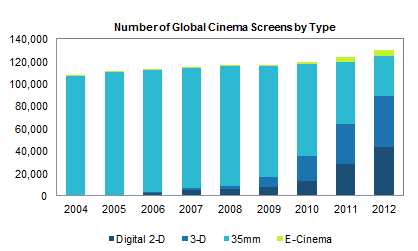
In 2012, mechanical film projectors were supplanted by digital electronic projection equipment in movie theaters worldwide, according to researcher IHS Screen Digest. The researcher estimates 43,796 2-D digital electronic screens in 2012, 45,545 3D digital screens and 5,500 E-cinema screens in 2012.
In contrast, there were just 35,087 mechanical projectors in 2012, down from 55,150 in 2011. Mechanical projectors use large reels of film; the electronic projectors employ computer-like digital storage.
“The first foray into digital technology in cinemas came with sound, and then indirectly with online ticketing, moving afterward onto cinema advertising, then digital cinema, digital 3-D and the use of social media,” David Hancock, senior principal analyst for cinema at HIS, says in a press release. “Outside of the films themselves, the industry side of the film business is also dealing with issues such as high and variable frame rates (HFR and VFR), 4K image capture, digital archiving, object-based sound, electronic distribution and a wide range of other issues. Cinemas are now at the nexus of consumer and industrial technologies, and applications and cinema owners will continue to respond to this trend during the year ahead.”
IHS Screen Digest feels the new hot-button issue is high frame rates—48 frames per second versus the 24 frames benchmark. For “The Hobbit,” IHS Screen Digest estimates that approximately 1,200 screens around the world upgraded their technology to play the HFR version—somewhat less than originally envisioned but still a “promising” start.
Dropping mechanical projectors has implications for small theaters, which cling to the old technology while film distributors stop ordering the manufacturer of bulky film prints necessary for such equipment. The cinema services company Cinedigm and two theater trade groups are working on making digital projection economically feasible for independent cinemas, and also drive in theaters.
Electronic projection took 15 years to catch on because mechanical projectors are reliable and, with improvements in electrical bulbs, do a good job. But the advent of 3D movies gave theaters the incentive to switch on a mass scale.
Related content:
Leave a Reply